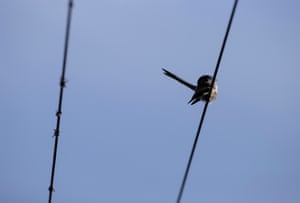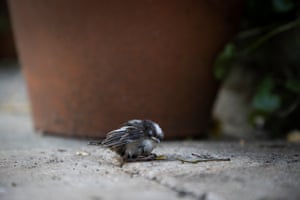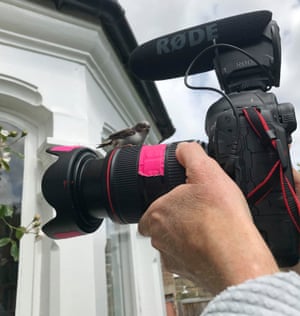“Bum barrels twit on bush and tree
Scarse bigger then a bumble bee
And in a white thorn’s leafy rest
It builds its curious pudding-nest
Wi hole beside as if a mouse
Had built the little barrel house.”John Clare, 18th-century English nature poet
Recently, I was told that I was showing classic signs of “biophilia” – I had to open a dictionary to learn this meant enjoying “the love of life or living systems” and displaying the psychological condition of being attracted to all that is alive and vital. I had just published a picture essay about some tulips that were flourishing in my back garden. I was nervous submitting it – here was a sports photographer, denied his usual fare because of the pandemic, trying his hand at something very different. I was pleasantly surprised by the response, with far more people getting in touch than I’ve ever had for a sports story.
The tulips died down, but sport was nowhere near a return. I needed something else and, fortunately, nature handed me another gift, a project that would test my photographic skills and give me the adrenaline buzz that I desperately missed from my normal job.
Just as lockdown had fully kicked in around my north London home, I couldn’t help but notice two tiny birds flitting around my front garden. I was a complete bird novice. I knew robins, mainly because of Christmas cards, and other birds because they were nicknames of football teams – magpies, eagles, seagulls, canaries, etc. Every year I go with my family to the wildlife photography exhibition at the Natural History Museum and marvel at the pictures, amazed by the skill, technique and patience needed to create such beautiful images. Did it make me want to do similar? Not really, sport was my thing and I was happy with that.

But these little birds kept grabbing my attention. We soon realised a nest was being built in the rose bush growing beside our front door. I had no idea what these birds were called, needing an uncle to identify them as long-tailed tits, Britain’s lightest bird and known as bum barrels. “You lucky things!” he said. These two were near-identical cute fluffballs with mainly black and white plumage tinged with bits of grey and pink. Only later, under close inspection of the photos, did I realise one had an orange eyeball, the other had yellow. They went everywhere together; I read that long-tailed tits often went round in large groups as an extended family but these two were by themselves. I decided I might as well follow them, seeing if I could get a decent frame or two. This was my chance to be a bird photographer, at least for a while.

At first it was really frustrating – I would see them on a branch but before I could focus they were off. They were so quick and seemed nervous of me. As for getting them in mid-air, their undulating and erratic flight seemed impossible to capture. I needed another approach: rather than chasing them around, I realised I had to be in place first and let them come to me. I began to learn their patterns of behaviour, noting routes they flew and places they visited. It reminded me of an approach I use in sports photography, getting to know “the hot zones”, areas where most action happens and the chance of success is greater. With these birds it tended to be near the rose bush, as they would always return there for nest building.

To improve my chances of a better picture, I researched the birds; expanding my knowledge of them could help me work out what they were doing. As I learned more about the birds I got closer to them. I started to get some half-decent images but all were of them sitting neatly on a branch or bush. I needed something a little more exciting and challenging, to show their character. Luckily for me they decided to provide exactly what I needed.
For about three weeks during their nest building they would have sudden mood changes. Most of the time, when perched, they looked calm and cute, but then, out of the blue, they would become aggressive. They began flying into my front windows, repeatedly hitting the glass. I’d never seen anything like this before and no other birds were doing it. I guessed they must have been confused by the reflections off the glass, attacking the mirror image of themselves, thinking it was a rival bird threatening their new nest. I know it might sound a little cruel but I found it fascinating – and not bad for pictures.


This behaviour could happen at any time during the day. We could be watching television when there would be a tap, tap, tap on the window – the angry birds. Sitting in my armchair I’d have a perfect view of the TV and the front window. There could be someone having their arm ripped off on the show Tiger King but my gaze was fixed elsewhere.
Some days were much quieter. I’d be sitting, poised with camera, waiting for the birds, but nothing. That didn’t seem too bad if I was inside but I would also sit outside, tucked away behind my bins in a basic attempt to disguise myself, getting some very strange looks from passersby, obviously questioning my mental wellbeing. The hours would pass, time enough for me to wonder myself about my own sanity, then suddenly there would be a flurry of action. It reminded me of being at a cricket match, waiting ages for something to happen, then boom, drama all over in a flash.


The birds seemed to have their favourite spots. Stretching across the street are a couple of old telephone wires, which they loved sitting on and bouncing in between. It gave them a perfect view down to the nest below and no other bird used them. It was part playground, part lookout, part bathroom and all theirs. Frequently, as the last rays of the setting sun hit the wires, the birds would wash themselves and dry off there.

I started to really admire these two birds, flying miles in constant shuttles, always checking where the other one was – their teamwork a pleasure to see. They were becoming my home team and I’d cheer for them. As I was spending so much time around them, the two birds seemed to relax and I could get much closer to them. At the same time, my ears were getting attuned to their calls, the high-pitched “see, see, see” as they communicated with each other. I could hear them from far away, tell when they were coming near and could raise a camera to be ready. The bird sounds were most obvious when danger presented itself. One day a neighbourhood cat began leaping off one of our bins into a privet hedge trying to catch them. I heard the danger call from one of our birds and rushed outside, arms waving madly, shooing at the top of my voice to scare the predator away. Another time I saw the two birds showing great tactical awareness, man-marking a potential egg-thieving magpie on a nearby chimney, blocking the route to its goal, the nest. I found out that 75% of long-tailed tit nests fail due to predators – these two parent birds, helped by me and my family, were determined to not let that happen. We all developed a connection with these birds – and a temporary hatred of cats and magpies.

Looking at the nest it was easy to see why the long-tailed tit has been called the structural engineer of the bird world. These two put together an amazing rugby-ball shaped construction with a small entrance hole about three-quarters of the way up. It was built from hair, moss, cobwebs and lichen but, most ingeniously of all, with silk from spider cocoons which made the nest elastic and stretchy, so when it was full of growing chicks it could expand with them. Once the outside was made the two birds set about finding a stash of feathers – up to 2,000 can be used – to line the inside, making it soft for the eggs to be laid.

When the nest was done the constant flying ceased. I presumed the eggs were laid as one bird would often stay behind, probably incubating, while the other found food. We loved it when we could see the bird’s head poking out of the nest entrance, watching the world go by. This pattern continued for quite a few days until I sensed something else was happening. I saw one of the birds with food in its mouth heading into the rose bush – a sure sign. Perched on top of a ladder I found a great view, in between branches straight through to the nest entrance which had a large pigeon feather pulled across, shielding the contents inside. The parent completely ignored me and poked its head inside – a tiny beak appeared.



From then on, growth for the chicks was rapid, fuelled by the endless food shuttles the parents were doing. Backwards and forwards they flew, laden with various insects and grubs. The chicks quickly lost their reptilian looks, gaining feathers and fluffing up. The distinctive white line of the long-tailed tit was on their heads, like they had tiny Mohican haircuts. It may be a stereotypical scene, seen countless times on television, thrusting beaks of egg-yolk yellow, eager to grab food from a parent, but it still gave me goosebumps witnessing it right there in front of me.

The chicks would desperately try to force themselves forward to the very edge of the entrance hole, hoping to be first in line for grub. This jostling of positions would often end up in squabbling and bickering – it struck a familiar chord with me. In between the regular feeds they would sleep, some with necks hanging right out of the nest, not wanting to lose their hard-earned priority position.

Unsure of exactly when the first chicks were born, I had to guess the day they might start leaving the nest. Fledging time was approaching. One day I looked out and saw the first chick had ventured from the nest and on to surrounding branches. After about 20 minutes of washing itself and wobbling around, very unsure on its feet, it decided that was enough and headed back inside the nest. The next day I went out very early. Looking down to the ground I saw two chicks had tumbled eight feet from the nest down to the concrete paving.

One was already dead, the other looked battered, shaken and groggy – a heartbreaking sight. We scooped up the injured one in a tiny bowl and placed it back in the rose bush. It was ignored by both parents – the question was, did these two chicks fall or were they pushed? Perhaps the nest got overloaded and they were forced out? I also started to think about my role. Should I be trying to save this chick? Was I interfering with nature? It’s obviously a frequent dilemma faced by many recording the natural world. The injured and scorned one fell out of the rose bush another couple of times, and each time we scooped it up and placed it back. After the fourth fall we had to make the decision to leave it to die. I was gutted. Another chick emerged from the nest and briefly wobbled around. Whether or not it saw its sibling lying on the paving below I can’t be sure, but it soon decided freedom was overrated and returned inside.



The next morning, while eating breakfast, I heard a commotion from the nest, one much louder than the usual arguments. Going out I couldn’t believe it – the sweetest chicks you could ever imagine emerging from the nest and perched in the branches of the rose bush, seven in total. A mass wash and unfurling of feathers was happening, the chattering noise incredible. Gradually they found their balance and bravery, wandering around before, one by one, they summoned up the courage to take their maiden flights, in this case around three feet over to the privet hedge. Some just about made it; some fell short, landing on a dustbin, window box or dwarf Christmas tree. One landed on my camera. Somehow they all managed to meet up in the privet hedge, where they began to mimic being back in the nest, squeezing together in a bundle of fluff and feather.

That first night out they went to sleep, seven in a row, packed tightly on a branch in the privet hedge. But the next morning, they had gone. I looked for ominous signs, like loose feathers, fearful that a cat or fox had found them. Thankfully there were none.

They had flown off and my feeling of responsibility had gone with them. I stood in my back garden, all around me a cacophony of tweets and squeaks as new wings were being tested out, but not the ones I was really interested in. Occasionally I spotted one of the parent birds in among all the others, blackbirds, thrushes, wrens and wood pigeons … and robins of course. Later that evening I saw one of our chicks in a tree near our bathroom window, looking tiny, out by itself in the wide, open world. But after that sighting I saw them no more. They were definitely gone.

It has been said that sport has often played a vital role at times of crisis, battles on the pitch taking the nation’s mind away from battles off it. This time, it’s clear to me that nature has stepped up to take on the role of the great distractor. Thanks to this wonderful family of tiny birds, the natural world handed me solace and respite, helping me keep my sanity during this crazy spring. Thank you my beautiful bum barrels, I’ll never forget you.